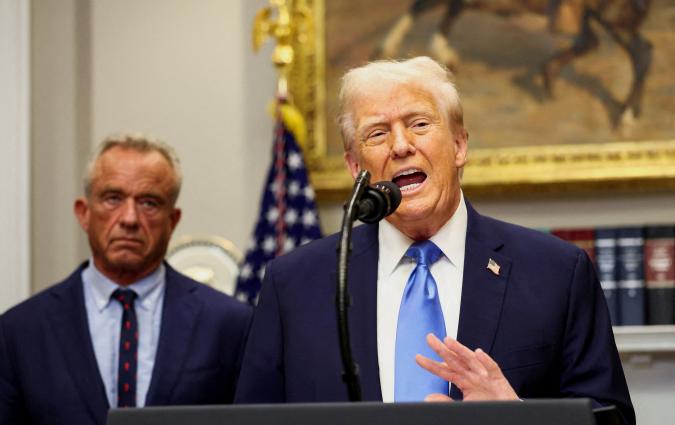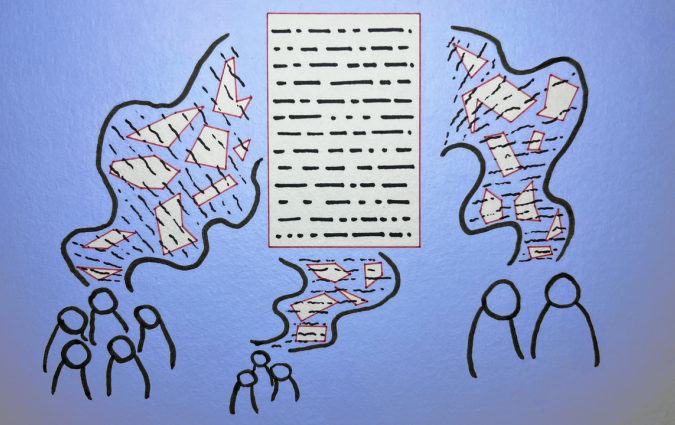Here are the ICA 2021 talks featuring researchers from the Reuters Institute

Members of the media are New York City, U.S. April 28, 2021. REUTERS/Andrew Kelly
As the 71st annual conference of the International Communication Association (ICA) unfolds online, we share the titles and abstracts of the talks prepared by the members of our research team. Attendees can find the talks by logging in to the conference platform.
Much of the work presented at ICA is work in progress, and some of the details contained in abstracts may have changed since they were submitted in November 2020.
Nudging news consumption: Evidence from a survey experiment
The consumption of false or misleading news and information represents a key challenge for societies. The need for consuming and disseminating trustworthy news has become more apparent with the coronavirus pandemic. In this study, we conduct a randomized, online survey experiment in the UK (N=3,061) to test whether social norm-based nudges can be used to influence individuals’ choice of news about the coronavirus pandemic. Our preliminary analysis shows that using a ‘trust nudge’ did not significantly reduce the likelihood of selecting a news article containing false information about the origins of coronavirus. However, it slightly increased the selection of a news article from highly trusted news sources like the BBC.
Political Communication > Interactive Poster Session
Ruling by exception: The secret, confusing world of social media content rule
This article explores the standard-setting that occurs when social media companies determine what content will be permissible on their platforms. This article argues that the rules are vague, occasionally incoherent, and lack transparency. The consequence for users and human rights activists is the engendering of a high degree of uncertainty. The ultimate conclusion is that reform is needed to ensure that the standards are detailed and transparent, and that they broadly reflect human rights principles.
Communication Law & Policy Division > Interactive Poster Session
Measuring the growth of online news use during coronavirus: Evidence from web tracking data in 20 countries
Richard Fletcher, Rasmus Kleis Nielsen
In this paper we use web tracking data from 20 countries to measure the growth of online news use during the Coronavirus pandemic. We find that (i) the time spent with online news between January to August 2020 grew sharply compared to the 2017-2019 average, with peak growth at least 50% higher than the previous three-year average in almost every country. However, using data on the severity of the outbreak, the stringency of the official response, and people’s mobility, we also find (ii) that the growth of online news use was at least partially mediated by lockdown measures and restrictions on social activity. In other words, although news use likely increased briefly and sharply around key events in the crisis, the more sustained growth we saw during the pandemic was likely a result of social restrictions rather than a direct effect of people actively informing themselves about coronavirus.
Journalism Studies > Pathways to COVID-19 News and (Mis)Information
Exploring the effect of trust in news organizations on coronavirus knowledge: Evidence from panel data in the UK
Richard Fletcher, Anne Schulz, Antonis Kalogeropoulos
Following several years of declining trust in key democratic institutions within society, the advent of the coronavirus crisis saw people in many countries “rally around” their national governments and news organizations. Since then, trust in the news media has been seen by many as central to how societies deal with the pandemic, given that the public response depends not only on the effective dissemination of knowledge and information about the virus, but also whether people have enough confidence in that information to internalize it and act accordingly. As such, we aim to explore the role of trust in news organizations for information about coronavirus in the UK for people’s knowledge about the pandemic. We draw on five waves of online survey panel data from the UK COVID-19 News and Information project, collected at two-week intervals between May and July 2020. Using Structural Equation Modelling we find that (i) some types of COVID-19 news use are positively associated with gaining knowledge about coronavirus (e.g. from the websites and apps of broadcasters), (ii) whereas others are negatively associated (e.g. from print newspapers/magazines and digital-born outlets). When it comes to trust in news outlets as a source of COVID-19 news and information, we find (iii) that this is a consistent predictor of people’s decision to use certain types of news outlets for coronavirus news, but (iv) we did not find a recurring direct link between trust in news outlets and knowledge gain. The findings show that although trust was important for understanding people’s news access behaviors during the first wave of the coronavirus crisis in the UK, its role in how people actually interpret the information they get from the news is less clear. We should also keep in mind that the coronavirus crisis is an extremely unusual situation in almost every way, where people’s attitudes and behaviors are in flux, and established techniques for understanding, for example, the relationship between news use and political knowledge, may not be completely appropriate for understanding how people acquire knowledge to protect themselves during a pandemic.
Political Communication > Spirals of Distrust: Vulnerabilities to Disinformation Across Countries, Citizens, and Time Political Communication
Don’t blame the media! The role of politicians and parties in fragmenting online political debate
Raphael Heiberger, Silvia Majó-Vázquez, Laia Castro, Rasmus K. Nielsen, Frank Esser
Democratic politics builds on both clear differences and shared common ground. While the rise of digital media may have enabled more differences to be articulated, common ground is often seen as threatened by fragmentation of political debate, which some see as driven by news media. The relative importance of political actors (parties and politicians) in driving fragmentation has received less attention. In this paper, we compare how news media and political actors contribute to the fragmentation of online political debate on the basis of analysis of almost half a million election-related tweets collected during the 2017 French, German, and UK national elections. We employ a Structural Topic Model to reduce online political debate to networks of topic overlap. Across the three countries with different political and media systems, we find news media are by far the most important actors in terms of creating and maintaining a common space of online political debate on Twitter. Our results also show that political actors, with some variation from country to country, contribute more to fragmentation as they focus on different topics while articulating clear differences. These findings underline the importance of complementing structural analysis of the rise of digital and social media with analysis of how important elite actors like news media and political parties/candidates use these media in different ways.
Political Communication > How the Communicative Behavior of Politicians Contributes to Political Polarization
The press in the doghouse: A comparative study of attitudes about watchdog journalism, trust in news, and news avoidance
Antonis Kalogeropoulos, Benjamin Toff, Richard Fletcher
The watchdog role has been one of the most widely discussed normative functions of the press. In this study we examine the public’s attitudes towards the news media’s watchdog performance and what role it plays in predicting trust in news and news avoidance, two important phenomena for democracy and the health of the public sphere. Based on data from the 2019 Reuters Institute Digital News Report, and controlling for a range of factors, we find that a) watchdog performance evaluations are positively associated with trust in news but that they are also positively associated with higher levels of news avoidance, b) evaluations of media in other functions like helping citizens understand the most important topics of the day and choosing relevant topics were stronger than watchdog performance evaluations in predicting trust in news and lower news avoidance levels respectively, c) politically oriented citizens (high in interest and stronger ideologues) are more likely to value watchdog performance evaluations for trust in news, and d) in countries with lower levels of press freedom respondents are more likely to avoid news if they perceive news media as successfully fulfilling their watchdog role.
Journalism Studies > News From the Audience Perspective
Narratives and patterns of toxicity in COVID-19 conversations on social media: A comparison across 6 countries
Silvia Majó-Vázquez, Manlio Domenico, Nicola Castaldo, Tom Nicholls, Lukas Erhard, Raphael Heiberger, Rasmus K. Nielsen
Social media has played a central role in mediating public conversation about the Covid-19 pandemic. Since the beginning of the crisis, the nature of these conversations has evolved amid the new restrictions imposed by governments and the increasing numbers of infected people and deaths. Notably, a significant amount of those conversations involving politicians and news media have been toxic or highly toxic. In this project we assess the patterns and narratives of the toxicity in social media messages in seven different countries: US, UK, India, Italy, France, Germany, Spain and India. We specifically study the role of political parties and major politicians and news media in driving toxic conversations or being targeted by toxic messages on Twitter. For this, we draw on a unique dataset including 50,878,194 geolocated Covid-related tweets published during the first wave of the pandemic, between 22 January and 31 August 2020. To identify the level of toxicity on messages in our dataset, we rely on a machine learning approach. Then, we study the patterns of audience attention around tweets involving political actors and news media in each country. In the next steps of this project, we will conduct a computer-assisted analysis of the textual content of the tweets. We will highlight the different narratives around lockdown at a country level, how these vary between high- and low-toxicity corpora, and how they relate to politicians, parties, and news media. Finally, we will study the volume of engagement of toxic messages along lines of the ideological dimension. For this, we will consider individual traits of the politicians and news outlets involved in toxic messages (partisanship, gender, race, type of news outlet etc.).
Computational Methods/Political Communication > HIGH-DENSITY: Computational Approaches to the Dark Side of Digital Communication
Defining news from an audience perspective at a time of crisis in the United States
Given prevailing questions about the definition of news in a contemporary US media environment, the present study analyzes audience views on news, exploring through in-depth interviews how 65 (largely moderate and liberal-leaning) individuals define it. These views are captured at a unique time: during the first wave of the coronavirus pandemic and George Floyd protests. Employing Media Dependency as a theoretical lens, it is argued that a time of crisis may crystallize audience views as people turn toward the media. In this context, findings indicate that audiences define news in very fundamental terms. But, reflecting individual differences and the nature of the contemporary media landscape, ‘news’ is often divorced from journalists/institutions, indicating a broadening of the concept for younger and less frequent/traditional news consumers. Older and more frequent/traditional news consumers view news in more institutional terms. The influences of the US media context, as well as the coronavirus pandemic and George Floyd protests, on views of news-ness are also discussed.
Journalism Studies > News From the Audience Perspective
The lure of local news among those who want politics. Exploring the role of political interest in local news consumption in seven countries
Anne Schulz, Joy Jenkins, Wiebke Möhring
While information abundance has become one of the main characteristics of today’s media environment, local and regional political communication environments have become ever more impoverished. Local news organisations have suffered cuts in staff, mergers, and closures often at the cost of local political coverage. Based on this, we explore (i) in how far local news remains interesting among politically interested individuals and (ii) how this compares to their interest in news more generally. We also investigate (iii) which local news sources politically interested audiences rely on. Using survey data from 2020 we (iv) compare findings across seven Western countries. We find political interest is linked to interest in local news, but it is significantly more important for interest in news in general. When controlling for interest in local news, political interest does not relate to using traditional media or social media for local news. However, it is consistently associated with using local institutions for local news. Findings are largely similar across countries.
Journalism Studies > The Role of Local Journalism for Communities and Individuals
News avoiders as social animals
Benjamin Toff, Ruth Palmer, Rasmus K. Nielsen
This chapter is from a book-in-progress about news avoidance, the practice of consuming little or no news, intentionally or unintentionally. Using survey data from the United States and a trove of more than 160 qualitative interviews conducted with news avoiders and news lovers in three different political information environments—the US, UK, and Spain—we examine who avoids the news, why, how they manage without it, whether avoiding news is actually a problem (we think it is), and what might be done about it. This chapter focuses on news avoidance as a social phenomenon, exploring how news avoiders’ folk theories about news and news consumption habits are shaped by various social forces, including early and ongoing socialization, and the social groups to which they belong.
Journalism Studies > News Avoiders and Hard-to-Reach Audiences







